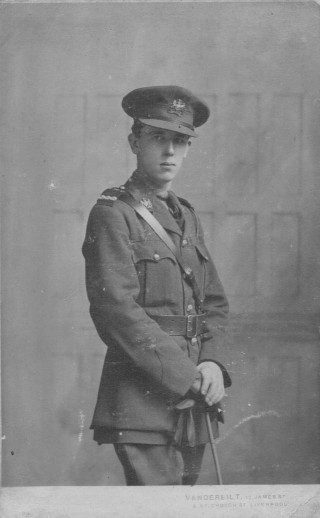Temp. Lt. Frederick J. SALISBURY, Royal Engineers
Frederick Salisbury who died on 23rd September 1919
John Collins and Lesley McCabe with some small additions based on Research by Ian Valentine & John Stewart
Temp. Lt. Frederick Salisbury of the Royal Engineers, Inland Water Transport Department. His birth in Southwick, Sussex was registered at Steyning Jan-Mar 1894, the first son of Marine Engineer George, and Eleanor Salisbury who had lived at 23 Tancred Road, Anfield, Liverpool. He was the brother of William Hunter Salisbury. The 1901 Census shows the family living at Newton, Wivenhoe, and the 1911 Census living at New Town Field, Wivenhoe. He died on 23rd September 1919, aged 25, is buried in Amara War Cemetery, Iraq Grave ref. XIV.D.6 and named on Wivenhoe War Memorial.
It is very probable that he had joined the army expecting to serve as an infantry officer like so very many others, but was selected for the Royal Engineers because of his previous knowledge of boats and rivers. The Royal Engineers were responsible for inland water transport, the supply and movement of the army using rivers and canals. He was posted to Mesopotamia (now Iraq). There were few roads and railways to keep the Army supplied and so the Tigris and Euphrates rivers were the main highways. The R.E. had a bit of a problem with personnel, in that most men with experience of boats were already in the R.N. (See H.M.S. Pirouette. and Ten paddle tugs)
Conditions in Mesopotamia defy description. Extremes of temperature, arid desert and flooding; flies, mosquitoes and other vermin: all led to appalling levels of sickness and death through disease. Under these incredible conditions, units fell short of officers and men, and all too often reinforcements were half-trained and ill-equipped. Medical arrangements were quite shocking, with wounded men spending up to two weeks on boats before reaching any kind of hospital.
This photograph of Frederick Salisbury was taken in Liverpool, and he has probably just finished his officer’s training, or is about to start it. He is wearing an officer’s uniform but no rank insignia other than the cadet’s white stripes on his epaulets. He also has the General Service cap badge indicating that he has yet to be appointed to a regiment.







Comments about this page
In fact, he is an officer commissioned on the General List attached to the Royal Engineers serving in the IWT. His rank insignia is a “wavey” bar worn by seagoing officers of that unit.
“He is wearing an officer’s uniform but no rank insignia other than the cadet’s white stripes on his epaulets. He also has the General Service cap badge indicating that he has yet to be appointed to a regiment.”
He is wearing the blue epaulettes of an officer in the IWT Section of the Royal Engineers, authorised under Army Order AO 347/1916. They have a gold button under which is the letters IWT and interlocking wavy gold lace indicating the rank of 2nd lieutenant, under the lace is a purple bar showing he is an engineer. All IWT “Marine Officers” were in the General or Special List, though some marine engineers were transferred to the Royal Engineers. In 1918, the interlocking wavy gold lace was changed to the more usual army “pips” but the blue epaulettes were continued.
New Town Field was the original name of Hamilton Road when it was built, about 1893. The 1901 census refers to the street as Newtown, not Newton. I believe the Salisbury’s house was the one now known as No.8, Hamilton Road
Add a comment about this page